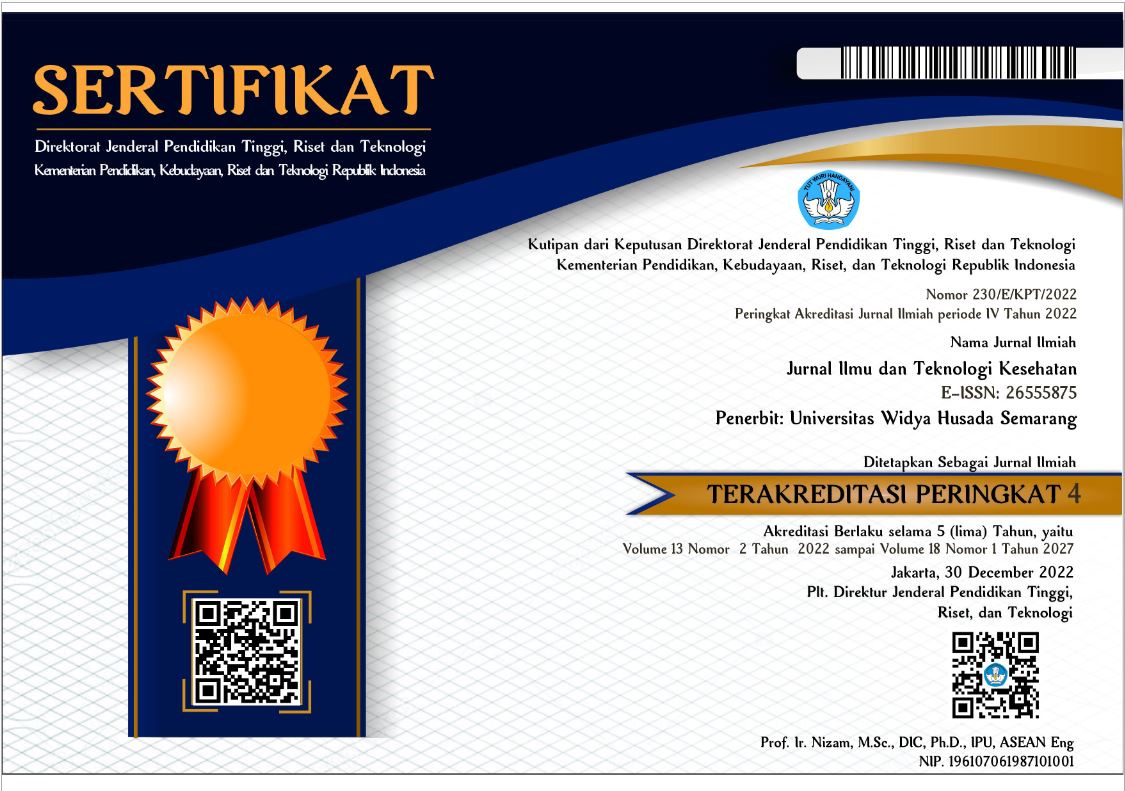ANALYSIS OF ANATOMICAL INFORMATION USING 1 RANGE: CASE STUDY OF EMERGENCY CT SCAN OF THE HEAD WITH CLINICAL MILD HEAD INJURY
Abstract
Keywords
Full Text:
PDFReferences
Aditya, D., & Apriantoro, N. H. (2020). Ct-Scan Kepala Dengan Klinis Trauma Kapitis Post Kecelakaan Lalu Lintas. KOCENIN Serial Konferens, 1(1), 1–7.
Firmada, M. A., Kristianti, M., Husain, F. ’, & Kunci, K. (2021). Manajemen Nyeri dengan Guide Imagery Relaxation pada Pasien Cedera Kepala Ringan di Instalasi Gawat Darurat (IGD) : Literature Review ARTIKEL INFO ABSTRAK. Aisyiyah Surakarta Journal of Nursing, 2(1), 20–25. https://jurnal.aiska-university.ac.id/index.php/ASJN
Lampignano, J. P., & Kendrick, L. E. (2018). Radiographic Positioning and Related Anatomy.
Manarisip, M. E. I., Oley, M. C., & Limpeleh, H. (2014). Gambaran CT Scan Kepala Pada Penderita Cedera Kepala Ringan di BLU RSUP Prof. Dr. R. D. Kandou Manado Periode 2012-2013. Journal E-CliniC (ECl), 2(2), 1–6. https://doi.org/10.35790/ecl.2.2.2014.5100
Mandang, M. W., Prasetyo, E., & Tangel, S. J. C. (2022). Role of 3D CT in Diagnosis of Skull Base Fractures. E-CliniC, 10(1), 136. https://doi.org/10.35790/ecl.v10i1.37806
Nasution, S. H. (2014). Mild Head Injury. In Fakultas Kedokteran Universitas Lampung Medula (Vol. 2, Issue 4).
Nurcahyo, P. W., Devina, M., Sulistiyadi, A. H., & Daryati, S. (2019). Informasi Diagnostik Gambaran Radiograf Cervical Hasil Multiplanar Reconstruction CT-Scan Kepala. Jurnal Radiografer Indonesia, 117, 75–88. https://doi.org/10.1016/j.ejrad.2019.05.007
Oktavian, P., Romdhoni, A. C., Dewanti, L., & Fauzi, A. Al. (2021). Clinical and Radiological Study of Patients With Skull Base Fracture After Head Injury. Folia Medica Indonesiana, 57(3), 192. https://doi.org/10.20473/fmi.v57i3.22824
Putri, D., & Fitria, C. N. (2018). Ketepatan dan Kecepatan Terhadap Life Saving Pasien Trauma Kepala. URECOL University Reseacrh Collequium, 846–855.
Rohmah, S., & Dewi, N. H. (2024). Emergency Nursing Care for Hypovolemia in Patients with Hemorrhage Due to Head Injury Asuhan Keperawatan Gawat Darurat Dengan Hipovolemia Pada Pasien Perdarahan Akibat Cedera Kepala. Journal of Nursing Studies, 1(2), 57–63.
Saputri, R., Angella, S., Salim, A., & Utama, J. (2023). Literatur Review Teknik Pemeriksaan CT-Scan Kepala Klinis Cephalgia. JRI (Jurnal Radiografer Indonesia), 6(2), 93–97. https://doi.org/10.55451/jri.v6i2.222
Sari, G. M., Triana, N., & Keperawatan, P. S. (2024). Pengaruh Stimulasi Sensory Family ’ S Auditory Terhadap. Jurnal Kesehatan Mercusuar, 7(1), 89–95.
Sidipratomo, P., Prija, T. K. S., Murtala, B., Purwadianto, A., & Lawrence, G. S. (2014). Role of Postmortem Multislice Computed Tomography Scan in Close Blunt Head Injury. The Indonesian Biomedical Journal, 6(2), 101. https://doi.org/10.18585/inabj.v6i2.36
Wintermark, M., Allen, J. W., Anzai, Y., Das, T., Flanders, A. E., & Galanaud, D. (2024). Standardized reporting for Head CT Scans in patients suspected of traumatic brain injury (TBI): An international expert endeavor. Springer Link Diagnostic Neuroradiology.
Yunus, M., Wahyudi, A., Febriyani, A. H., Asla Romizah, R., Radiologi RSU Daerah Pagar Alam Way Kanan, D. Z., Pendidikan Dokter, P., & Author, K. (2020). Karakteristik Hasil CT-Scan Penderita Cedera Kepala di RS Dr. H. Abdul Moeloek 2018. ARTERI: Jurnal Ilmu Kesehatan, 1(3), 177–183.
DOI: https://doi.org/10.33666/jitk.v16i1.650
Refbacks
- There are currently no refbacks.

This work is licensed under a Creative Commons Attribution 4.0 International License.
| Published by : Widya Husada Semarang University | ISSN : 2086-8510 (Print) | ISSN : 2655-5875 (Online) | |
| INDEXED BY | |||
 |  |  |  |
| MAP LOCATION | |||






